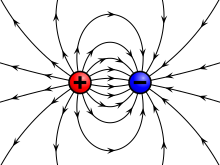
In science, a field is a physical quantity, represented by a scalar, vector, or tensor, that has a value for each point in space and time.[1][2][3] An example of a scalar field is a weather map, with the surface temperature described by assigning a number to each point on the map. A surface wind map,[4] assigning an arrow to each point on a map that describes the wind speed and direction at that point, is an example of a vector field, i.e. a 1-dimensional (rank-1) tensor field. Field theories, mathematical descriptions of how field values change in space and time, are ubiquitous in physics. For instance, the electric field is another rank-1 tensor field, while electrodynamics can be formulated in terms of two interacting vector fields at each point in spacetime, or as a single-rank 2-tensor field.[5][6][7]
In the modern framework of the quantum field theory, even without referring to a test particle, a field occupies space, contains energy, and its presence precludes a classical "true vacuum".[8] This has led physicists to consider electromagnetic fields to be a physical entity, making the field concept a supporting paradigm of the edifice of modern physics. Richard Feynman said, "The fact that the electromagnetic field can possess momentum and energy makes it very real, and [...] a particle makes a field, and a field acts on another particle, and the field has such familiar properties as energy content and momentum, just as particles can have."[9] In practice, the strength of most fields diminishes with distance, eventually becoming undetectable. For instance the strength of many relevant classical fields, such as the gravitational field in Newton's theory of gravity or the electrostatic field in classical electromagnetism, is inversely proportional to the square of the distance from the source (i.e. they follow Gauss's law).
A field can be classified as a scalar field, a vector field, a spinor field or a tensor field according to whether the represented physical quantity is a scalar, a vector, a spinor, or a tensor, respectively. A field has a consistent tensorial character wherever it is defined: i.e. a field cannot be a scalar field somewhere and a vector field somewhere else. For example, the Newtonian gravitational field is a vector field: specifying its value at a point in spacetime requires three numbers, the components of the gravitational field vector at that point. Moreover, within each category (scalar, vector, tensor), a field can be either a classical field or a quantum field, depending on whether it is characterized by numbers or quantum operators respectively. In this theory an equivalent representation of field is a field particle, for instance a boson.[10]
- ^ John Gribbin (1998). Q is for Quantum: Particle Physics from A to Z. London: Weidenfeld & Nicolson. p. 138. ISBN 0-297-81752-3.
- ^ Richard Feynman (1970). The Feynman Lectures on Physics Vol II. Addison Wesley Longman. ISBN 978-0-201-02115-8.
A 'field' is any physical quantity which takes on different values at different points in space.
- ^ Ernan McMullin (2002). "The Origins of the Field Concept in Physics" (PDF). Phys. Perspect. 4 (1): 13–39. Bibcode:2002PhP.....4...13M. doi:10.1007/s00016-002-8357-5. S2CID 27691986.
- ^ SE, Windyty. "Windy as forecasted". Windy.com/. Retrieved 2021-06-25.
- ^ Lecture 1 | Quantum Entanglements, Part 1 (Stanford), Leonard Susskind, Stanford, Video, 2006-09-25.
- ^ Richard P. Feynman (1970). The Feynman Lectures on Physics Vol I. Addison Wesley Longman.
- ^ Richard P. Feynman (1970). The Feynman Lectures on Physics Vol II. Addison Wesley Longman.
- ^ John Archibald Wheeler (1998). Geons, Black Holes, and Quantum Foam: A Life in Physics. London: Norton. p. 163. ISBN 9780393046427.
- ^ Richard P. Feynman (1970). The Feynman Lectures on Physics Vol I. Addison Wesley Longman.
- ^ Steven Weinberg (November 7, 2013). "Physics: What We Do and Don't Know". New York Review of Books. 60 (17).